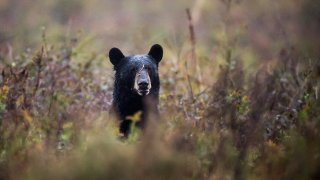
As Maryland black bears emerge from hibernation, the state’s Wildlife and Heritage Service is warning people to keep food tucked away to avoid attracting them.
In March and April, the bears began leaving dens after a four-month hibernation, and are searching for food.
The bears’ natural food sources, such as berries or nuts, will not be plentiful until later in the spring and summer, so they might be attracted to nearby “human-generated food sources,” according to a news release from the Maryland Dept. of Natural Resources Wildlife and Heritage Service.
The department has advised residents to be vigilant and keep their garbage in a bear-proof bin or a locked shed, and to store their grills inside.
We're making it easier for you to find stories that matter with our new newsletter — The 4Front. Sign up here and get news that is important for you to your inbox.
Bears in Maryland are most populous in four western counties — Allegany, Frederick, Garrett, and Washington — however in the coming months when the young, juvenile bears separate from their mother and find new territory, they can spread out all over the state, according to the news release.
The Wildlife and Heritage Service stated it is important to avoid man-made attractions for bears as it reduces the chance of “human-bear conflicts” as well as damage.
Between 2009-2019, there have been an average of 480 or more nuisance calls every year for bears as well as over $18,000 in agricultural damage, according to the Wildlife and Heritage Service.
Local
Washington, D.C., Maryland and Virginia local news, events and information
The Black Bear Damage Reimbursement Fund was created by the service in order to provide financial relief to farmers that have sustained damage to their property from bears.
The bear population has been steadily rising in the state.
Due to the large traveling range of bears, whole population estimates are difficult and expensive to conduct.
The last one was published in 2011, and estimated 701 adult and subadult bears in Garrett and Allegany counties.
However, the growing population is routinely monitored through annual mortality, den, and reproduction surveys, and now there are 2,250 black bears residing across Allegany, Garrett, Washington, and Frederick counties, according to Harry Spiker, the Game Mammal Section leader for the Wildlife and Heritage Service.
In the 2021 Bear Den Survey, Spiker told Capital News Service, the department tagged 13 bear cubs from five sows, or female bears, in March, averaging 2.6 cubs per sow.
“The Department has been conducting this survey since the mid-1980s and the long-term average is 2.9 cubs per sow, which is very good production, and indicates that our bears are healthy and living in a good quality habitat,” Spiker said.
In order to control population growth, the Maryland Bear Hunt was reinstated in 2004 after 51 years.
The bear hunting season is open for five days in October, and each permitted hunter is allowed to harvest one bear.
Since 2014, the department has eliminated the previous quota system that capped the total number of bears that could be harvested.
In 2020, the bear hunt went on despite the ongoing COVID-19 pandemic; 950 permits were issued to hunters and 117 black bears were harvested in total.
In a news release published by the department after the 2020 bear hunt, Wildlife and Heritage Service Director Paul Peditto commented on the success of the hunt.
“With such an expanding and healthy bear population throughout western Maryland, this hunt is an essential management tool,” Peditto said.
The 2021 Maryland Bear Hunt will take place from Oct. 25 to Oct. 29 in the Allegany, Frederick, and Washington counties.
Hunters who want to participate in the hunt fill out an application (https://compass.dnr.maryland.gov/) in August, and permits are issued via a lottery system in September, according to Spiker.
___
This article was provided to The Associated Press by the University of Maryland’s Capital News Service.



